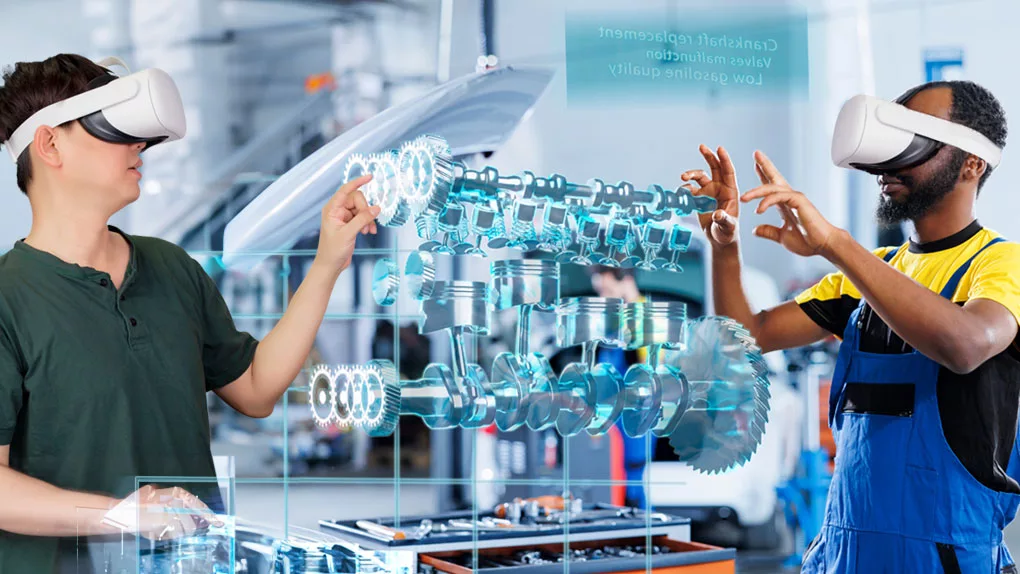“Mixed Reality (MR) combines virtual reality (VR) and augmented reality (AR), opening new perspectives for training. While VR immerses the user completely in a digital environment, MR overlays virtual elements onto the real world, creating a dynamic interaction between the two. Let’s explore the benefits of MR in training and how it could transform learning methods.”
Advantages of Mixed Reality Compared to Virtual Reality
The rise of Mixed Reality (MR) is transforming how professionals interact with their environment by innovatively blending the real and virtual worlds. Unlike Virtual Reality (VR), which isolates users in a fully digital universe, MR allows for partial immersion, keeping users connected to the physical world while interacting with virtual elements. This approach reduces disorientation and visual fatigue that can be associated with VR.
Training scenarios in Mixed Reality (MR) can be directly applied to real work environments, facilitating relevant contextual learning. For example, a technician can see virtual instructions overlaid on a real machine, enhancing the effectiveness of hands-on training. This contextual method allows for immediate integration of acquired skills, making the training directly applicable.
MR also stands out for its ability to facilitate real-time collaboration, whether in the same physical space or remotely. Users can manipulate avatars and virtual objects together, which encourages collaborative learning. They can also use their hands and gestures to interact with objects, making the experience closely resemble real-world interactions.
In terms of equipment, the situation is evolving rapidly. New MR headsets, such as those offered by Meta or Pico, combine the capabilities of MR and VR, providing increased versatility. This integration reduces the need to choose between different devices for various applications. Additionally, these headsets have become very financially accessible, allowing for wider adoption within companies. The industry is moving towards more integrated and affordable solutions.
Mixed reality also offers significant economic benefits. It allows for training employees directly at their workplace, thus reducing travel costs and the need for dedicated training facilities. Sessions can be conducted on demand, minimizing interruptions to operations.
Practical Applications of Mixed Reality in Continuing Education
By integrating virtual elements into a real environment, mixed reality (MR) is particularly advantageous for contextual training. In the industrial sector, technicians can see virtual instructions overlaid on real machines. This enables practical and immediate training: learners apply instructions in real time, avoid mistakes, and enhance operational efficiency.
In maintenance and repair, MR provides visual guides and step-by-step instructions. This enables technicians to resolve complex issues more quickly without waiting for an expert or, if necessary, by bringing in an expert remotely.
Continuing education often involves preparing for complex and varied situations. MR allows for the creation of realistic simulations of these scenarios, giving learners the opportunity to practice and develop key skills in a controlled environment. In the medical field, surgeons can train on delicate procedures with patient holograms, without risking real patients.
As mentioned, MR promotes real-time collaboration, whether in the same physical space or remotely. This approach is particularly useful for geographically dispersed teams, allowing for consistent and simultaneous training without the logistical constraints of travel.
Training scenarios in Mixed Reality (MR) can be directly applied to real work environments, facilitating relevant contextual learning. For example, a technician can see virtual instructions overlaid on a real machine, enhancing the effectiveness of hands-on training. This contextual method allows for immediate integration of acquired skills, making the training directly applicable.
MR also stands out for its ability to facilitate real-time collaboration, whether in the same physical space or remotely. Users can manipulate avatars and virtual objects together, which encourages collaborative learning. They can also use their hands and gestures to interact with objects, making the experience closely resemble real-world interactions.
In terms of equipment, the situation is evolving rapidly. New MR headsets, such as those offered by Meta or Pico, combine the capabilities of MR and VR, providing increased versatility. This integration reduces the need to choose between different devices for various applications. Additionally, these headsets have become very financially accessible, allowing for wider adoption within companies. The industry is moving towards more integrated and affordable solutions.
Mixed reality also offers significant economic benefits. It allows for training employees directly at their workplace, thus reducing travel costs and the need for dedicated training facilities. Sessions can be conducted on demand, minimizing interruptions to operations.
Some "concrete-concrete" examples:
Engineering and construction
- 3D modeling and design projects: Engineers and architects can use AR to visualize 3D building models directly on the construction site, identifying and resolving potential issues in real time.
- Construction site safety: AR can be used to train workers on safety protocols by overlaying instructions and virtual hazard zones onto the real site. This helps workers better understand the risks and the safety measures to apply.
Several years ago, Audace developed its very first AR system for Orano on the theme of safety. In collaboration with ORANO RD, AUDACE created a training and visualization tool for ionizing points within EDF CPE workshops. Instructions and advice appear in the operator’s glasses at each stage of the intervention, as well as “hot spots” to avoid. This enables the operator to progress quickly in their real environment with minimal risk of exposure.
In maintenance and repair, MR provides visual guides and step-by-step instructions. This enables technicians to resolve complex issues more quickly without waiting for an expert or, if necessary, by bringing in an expert remotely.
Continuing education often involves preparing for complex and varied situations. MR allows for the creation of realistic simulations of these scenarios, giving learners the opportunity to practice and develop key skills in a controlled environment. In the medical field, surgeons can train on delicate procedures with patient holograms, without risking real patients.
As mentioned, MR promotes real-time collaboration, whether in the same physical space or remotely. This approach is particularly useful for geographically dispersed teams, allowing for consistent and simultaneous training without the logistical constraints of travel.
Training scenarios in Mixed Reality (MR) can be directly applied to real work environments, facilitating relevant contextual learning. For example, a technician can see virtual instructions overlaid on a real machine, enhancing the effectiveness of hands-on training. This contextual method allows for immediate integration of acquired skills, making the training directly applicable.
MR also stands out for its ability to facilitate real-time collaboration, whether in the same physical space or remotely. Users can manipulate avatars and virtual objects together, which encourages collaborative learning. They can also use their hands and gestures to interact with objects, making the experience closely resemble real-world interactions.
In terms of equipment, the situation is evolving rapidly. New MR headsets, such as those offered by Meta or Pico, combine the capabilities of MR and VR, providing increased versatility. This integration reduces the need to choose between different devices for various applications. Additionally, these headsets have become very financially accessible, allowing for wider adoption within companies. The industry is moving towards more integrated and affordable solutions.
Mixed reality also offers significant economic benefits. It allows for training employees directly at their workplace, thus reducing travel costs and the need for dedicated training facilities. Sessions can be conducted on demand, minimizing interruptions to operations.
Logistics and supply chain management
- Warehouse optimization: Warehouse managers can use mixed reality to improve organization and stock management. This technology allows real-time display of product locations, picking paths, and inventory levels. This helps employees locate items more quickly, optimize picking routes, and reduce picking errors, thereby increasing operational efficiency.
Aerospace maintenance
- Aircraft maintenance simulation: Maintenance technicians can receive detailed training on aircraft maintenance using 3D models overlaid on real aircraft or specific parts of aircraft. This allows for realistic and safe practice of procedures without taking operational aircraft out of service.
Automotive industry
- Design and prototyping: Automotive designers can use mixed reality to visualize and adjust 3D prototypes in a real-world environment, facilitating the design process and reducing the need for costly physical prototypes.
- Repair: Repair technicians can see schematics and repair steps overlaid on actual vehicles.
Here again, Audace has proven experience. In collaboration with Exxotest, Audace developed a training tool for diagnosing and repairing faults in Volvo D8 industrial engine machines.
Training in customer service and sales
- Customer service scenarios: Employees can train to handle various customer service situations through interactive RM simulations. This may include interactions with client avatars, allowing employees to practice their communication and problem-solving skills.
- Product visualization: Sales representatives can use RM to present complex or bulky products to clients. For example, an industrial machinery salesperson can showcase a virtual version of the machine in the client’s factory, facilitating the understanding of the product’s benefits and its on-site integration.
Indeed, mixed reality offers almost limitless possibilities for continuous training across various professional fields. By integrating interactive virtual elements into real environments, it enables immersive, practical, and effective learning experiences. RM transforms the way skills are acquired and refined, making training more accessible and relevant to the specific needs of each sector.

